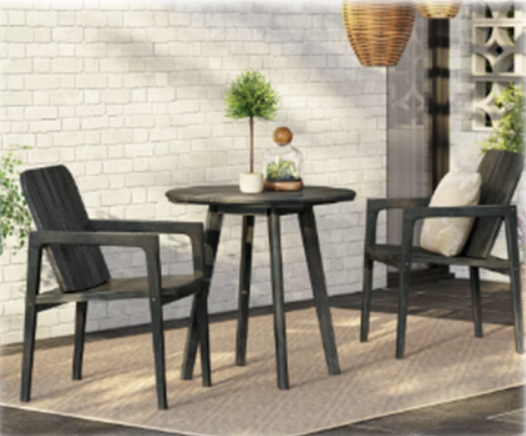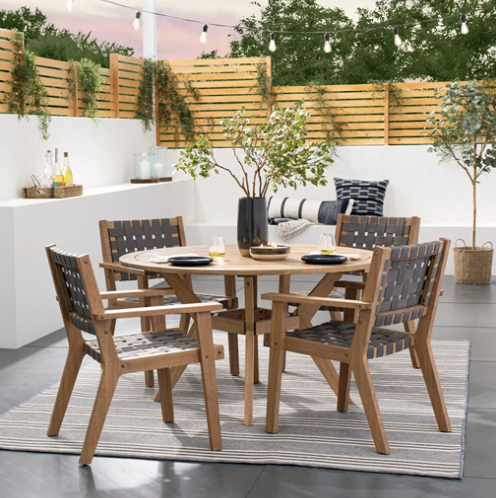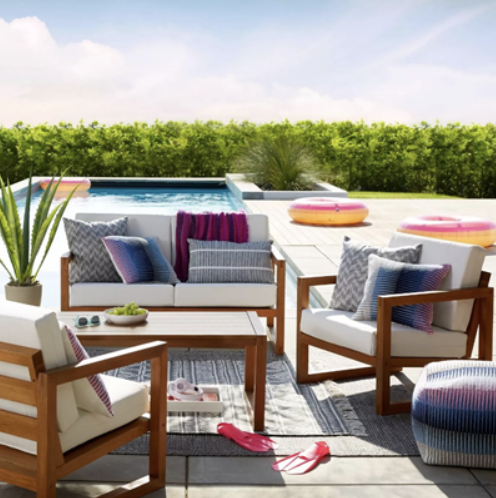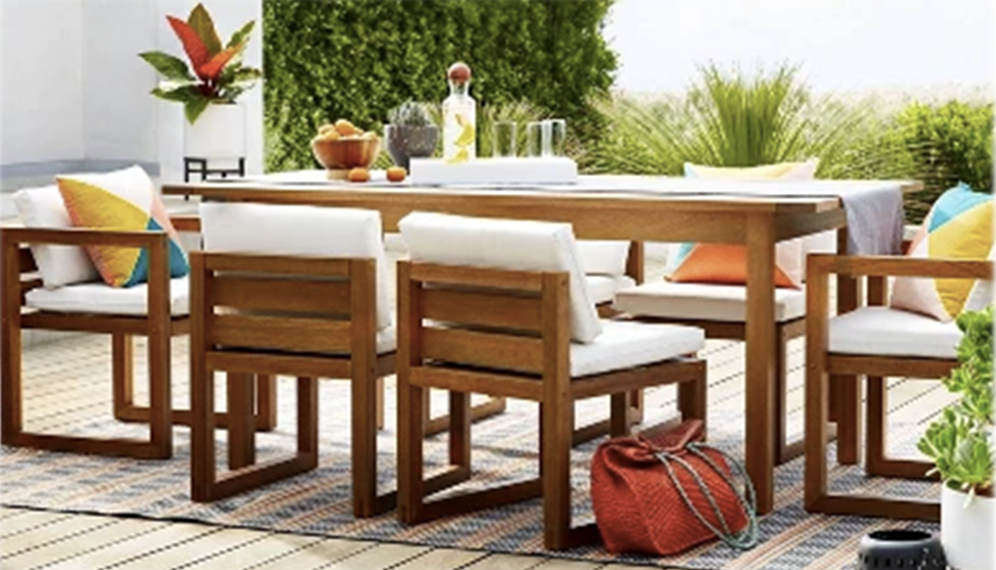What is the Best Wood for Outdoor Furniture? Exploring 4 Types of Outdoor Furniture Wood
Which type of wood is optimal for outdoor furniture?
Teak is optimal for its durability and timeless beauty for outdoor furniture.
Its natural resistance to decay and pests ensures longevity with minimal maintenance.
However, there is other wood that is also suitable for outdoor furniture!
-
Eucalyptus
Eucalyptus wood features a charming, wavy grain and enduring reddish hue that remains vibrant with regular oiling.
Its inherent durability enhances water resistance, eliminating concerns about moisture damage for outdoor furniture.
With proper maintenance, including annual sealing, eucalyptus wood offers both comfort and longevity, making it a popular and cost-effective choice among outdoor furniture options.
-
Acacia
Acacia wood boasts a wide range of colors and an attractively smooth grain, adding a natural touch to any space.
With a long lifespan and minimal risk of expansion or contraction, it's resistant to fungi, insects, rot, and humidity, making it weather-proof.
Easy to clean and maintain, acacia wood is extremely flexible and elastic, although painting with opaque colors is recommended to conceal its varied color tones and knotty appearance.
-
White oak
White oak, characterized by its light to medium brown color with an olive tinge, is highly durable and commonly utilized in boatbuilding and railroad ties.
Its large pore structure allows for easy staining, resulting in a smooth finish, and it is particularly suitable for steam-bending.
White oak is resistant to wear, rot, and decay, making it a popular choice for outdoor furniture.
It offers moderate pricing for domestic hardwood.
Thicker planks and labor-intensive quarter-sawn options may be slightly pricier compared to alternatives like Eucalyptus.
Overview of the 4 common types of outdoor furniture wood
|
Wood for outdoor furniture |
Teak | Eucalyptus | Acacia |
White Oak |
|||
|
Color |
|
|
|
the brown from light to medium | |||
|
Average Price (per Board Foot) |
|
|
|
$10~$17 | |||
|
Properties |
It's the most durable wood species for outdoor use but also the most expensive. | Eucalyptus has a very clean wood surface without knots and open grains to give you a sleek and clean look on your outdoor furniture. | Acacia is considered rot and fungi resistant in the outdoor environment. It is recommended to apply opaque paint to effectively conceal knots and color variations in the wood. | Oak is with open grains so grains will be very obvious after finished with paint. | |||
|
Weather resistant |
|
Strong | Moderate |
|
|||
|
Durability |
|
Strong | Moderate |
|
|||
|
Water-resistant |
|
Strong | Moderate |
|
|||
|
Maintenance |
Easy | Apply sealant to wood outdoor furniture every year for continued resistance. | To avoid discoloration and absorbing moisture, paint or polish on wood | Apply sealant to wood outdoor furniture every year for continued resistance. |
3 Tips for Choosing the Suitable Wood for Outdoor Patio Furniture
Based on the table above, it is obvious that teak is the optimal material for outdoor furniture wood.
Here are three selecting tips for “Teak” :
-
Teak Wood Selection Tips 1 : Natural Durability
Teak wood is resistant to rot, decay, and pests due to its dense grain and high oil content, ensuring long-lasting outdoor use without warping.
Knots, while adding character, do not compromise its longevity.
-
Teak Wood Selection Tips 2 : Low Maintenance
Teak wood requires minimal upkeep; occasional soap and water cleaning maintains its appearance and prevents sun-induced discoloration.
-
Teak Wood Selection Tips 3 : Timeless Aesthetic
Teak wood develops a rich patina over time, complementing light-colored surroundings effortlessly for an elegant outdoor look.
To evaluate the quality of outdoor patio furniture wood, check for knots and signs of deterioration, which may compromise safety.
Sintai sets itself apart by sourcing high-quality wood with minimal knots, prioritizing durability and affordability in its patio furniture range.
Crafting Outdoor Comfort & Quality: Sintai's Premium Patio Wood Furniture in Three Different Sizes
Step into the world of outdoor elegance with Sintai's premium patio wood furniture collection.
Experience the perfect blend of comfort, durability, and style as you explore our meticulously crafted pieces to enhance any outdoor space.
From cozy balconies to spacious garden terraces, Sintai offers a range of sizes to suit every setting and preference.
Explore our range of offerings, including the following types:
|
Small Sized Patio |
|
|
||
|---|---|---|---|---|
|
7ft x 7ft = 49 sq. ft. |
|
|
||
|
2-3 people |
4-5 people |
6-8 people |
-
Small Sized Wooden Outdoor Furniture Patio (7ft x 7ft = 49 sq. ft.):

The bistro set includes a round patio table with two chairs, or you can choose a table with a single bench.
There's also an option with the round coffee table and lounge chair set.
-
Mid-Sized Wooden Outdoor Furniture Patio (12ft x 14ft = 168 sq. ft.):

A coffee table with two lounge chairs, or a loveseat would fit perfectly.
There's also a 5-piece outdoor dining set that is available with an umbrella on a patio of this size.
> Know more about how to choose a perfect wooden patio umbrella!
-
Large Sized Wooden Outdoor Furniture Patio (16ft x 18ft = 288 sq. ft.):

In size, having the capacity to cover a conversation set as well as a 6 to 8-person dining set inside a gazebo to make the whole patio of this size a great social destination.
> Know more about how to build a wooden outdoor gazebo!
Guide to maintaining wood furniture
Aside from knowing how to select suitable furniture for different occasions, regular proper care is necessary to ensure long-lasting enjoyment of outdoor spaces, irrespective of the wood type chosen, and to extend longevity.
The basic maintenance steps for wood furniture
-
Dust removal:
Gently dust with a soft cloth or wipe with a slightly damp cloth regularly to reduce damage to the wood surface.
No need to add detergent.
-
Regular maintenance:
Regularly apply oil or wax, inquire with the merchant about the suitable maintenance method for the wood species, and perform maintenance every six months to a year.
-
Avoid collisions:
Avoid collisions with metal products or sharp objects to prevent scratches or impacts.
-
Avoid staining:
Avoid prolonged contact with staining items such as fruits, dyes, or printed materials.
-
Avoid direct sunlight:
Avoid exposing solid wood furniture to high-temperature sunlight to prevent cracking.
-
Avoid direct air conditioning:
Avoid direct blowing of air conditioning to prevent wood from cracking or deforming.
-
Avoid liquid residue:
Avoid liquid residue on the surface, and wipe dry in time.
- Do not use cleaning products:
Avoid using alcohol, detergents, and other liquid cleaners.
Only wipe with water to avoid damaging the wood.
Transform Your Space with Sintai's Best Selection Today!
Shop with Sintai to upgrade your home and garden with Sintai's premium indoor and outdoor furniture. From elegant interiors to cozy outdoor setups, we have everything you need to create the perfect atmosphere!
Looking for Bulk Orders or Customized Designs?
Sintai specializes in creating tailored indoor and outdoor furniture solutions to fit your unique needs. Whether it's bulk orders or personalized designs, we've got you covered!
Contact us today: sales@sintai-group.com
Which type of wood is optimal for outdoor furniture?
Teak is optimal for its durability and timeless beauty for outdoor furniture.
Its natural resistance to decay and pests ensures longevity with minimal maintenance.
However, there is other wood that is also suitable for outdoor furniture!
-
Eucalyptus
Eucalyptus wood features a charming, wavy grain and enduring reddish hue that remains vibrant with regular oiling.
Its inherent durability enhances water resistance, eliminating concerns about moisture damage for outdoor furniture.
With proper maintenance, including annual sealing, eucalyptus wood offers both comfort and longevity, making it a popular and cost-effective choice among outdoor furniture options.
-
Acacia
Acacia wood boasts a wide range of colors and an attractively smooth grain, adding a natural touch to any space.
With a long lifespan and minimal risk of expansion or contraction, it's resistant to fungi, insects, rot, and humidity, making it weather-proof.
Easy to clean and maintain, acacia wood is extremely flexible and elastic, although painting with opaque colors is recommended to conceal its varied color tones and knotty appearance.
-
White oak
White oak, characterized by its light to medium brown color with an olive tinge, is highly durable and commonly utilized in boatbuilding and railroad ties.
Its large pore structure allows for easy staining, resulting in a smooth finish, and it is particularly suitable for steam-bending.
White oak is resistant to wear, rot, and decay, making it a popular choice for outdoor furniture.
It offers moderate pricing for domestic hardwood.
Thicker planks and labor-intensive quarter-sawn options may be slightly pricier compared to alternatives like Eucalyptus.
Overview of the 4 common types of outdoor furniture wood
|
Wood for outdoor furniture |
Teak | Eucalyptus | Acacia |
White Oak |
|||
|
Color |
|
|
|
the brown from light to medium | |||
|
Average Price (per Board Foot) |
|
|
|
$10~$17 | |||
|
Properties |
It's the most durable wood species for outdoor use but also the most expensive. | Eucalyptus has a very clean wood surface without knots and open grains to give you a sleek and clean look on your outdoor furniture. | Acacia is considered rot and fungi resistant in the outdoor environment. It is recommended to apply opaque paint to effectively conceal knots and color variations in the wood. | Oak is with open grains so grains will be very obvious after finished with paint. | |||
|
Weather resistant |
|
Strong | Moderate |
|
|||
|
Durability |
|
Strong | Moderate |
|
|||
|
Water-resistant |
|
Strong | Moderate |
|
|||
|
Maintenance |
Easy | Apply sealant to wood outdoor furniture every year for continued resistance. | To avoid discoloration and absorbing moisture, paint or polish on wood | Apply sealant to wood outdoor furniture every year for continued resistance. |
3 Tips for Choosing the Suitable Wood for Outdoor Patio Furniture
Based on the table above, it is obvious that teak is the optimal material for outdoor furniture wood.
Here are three selecting tips for “Teak” :
-
Teak Wood Selection Tips 1 : Natural Durability
Teak wood is resistant to rot, decay, and pests due to its dense grain and high oil content, ensuring long-lasting outdoor use without warping.
Knots, while adding character, do not compromise its longevity.
-
Teak Wood Selection Tips 2 : Low Maintenance
Teak wood requires minimal upkeep; occasional soap and water cleaning maintains its appearance and prevents sun-induced discoloration.
-
Teak Wood Selection Tips 3 : Timeless Aesthetic
Teak wood develops a rich patina over time, complementing light-colored surroundings effortlessly for an elegant outdoor look.
To evaluate the quality of outdoor patio furniture wood, check for knots and signs of deterioration, which may compromise safety.
Sintai sets itself apart by sourcing high-quality wood with minimal knots, prioritizing durability and affordability in its patio furniture range.
Crafting Outdoor Comfort & Quality: Sintai's Premium Patio Wood Furniture in Three Different Sizes
Step into the world of outdoor elegance with Sintai's premium patio wood furniture collection.
Experience the perfect blend of comfort, durability, and style as you explore our meticulously crafted pieces to enhance any outdoor space.
From cozy balconies to spacious garden terraces, Sintai offers a range of sizes to suit every setting and preference.
Explore our range of offerings, including the following types:
|
Small Sized Patio |
|
|
||
|---|---|---|---|---|
|
7ft x 7ft = 49 sq. ft. |
|
|
||
|
2-3 people |
4-5 people |
6-8 people |
-
Small Sized Wooden Outdoor Furniture Patio (7ft x 7ft = 49 sq. ft.):

The bistro set includes a round patio table with two chairs, or you can choose a table with a single bench.
There's also an option with the round coffee table and lounge chair set.
-
Mid-Sized Wooden Outdoor Furniture Patio (12ft x 14ft = 168 sq. ft.):

A coffee table with two lounge chairs, or a loveseat would fit perfectly.
There's also a 5-piece outdoor dining set that is available with an umbrella on a patio of this size.
> Know more about how to choose a perfect wooden patio umbrella!
-
Large Sized Wooden Outdoor Furniture Patio (16ft x 18ft = 288 sq. ft.):

In size, having the capacity to cover a conversation set as well as a 6 to 8-person dining set inside a gazebo to make the whole patio of this size a great social destination.
> Know more about how to build a wooden outdoor gazebo!
Guide to maintaining wood furniture
Aside from knowing how to select suitable furniture for different occasions, regular proper care is necessary to ensure long-lasting enjoyment of outdoor spaces, irrespective of the wood type chosen, and to extend longevity.
The basic maintenance steps for wood furniture
-
Dust removal:
Gently dust with a soft cloth or wipe with a slightly damp cloth regularly to reduce damage to the wood surface.
No need to add detergent.
-
Regular maintenance:
Regularly apply oil or wax, inquire with the merchant about the suitable maintenance method for the wood species, and perform maintenance every six months to a year.
-
Avoid collisions:
Avoid collisions with metal products or sharp objects to prevent scratches or impacts.
-
Avoid staining:
Avoid prolonged contact with staining items such as fruits, dyes, or printed materials.
-
Avoid direct sunlight:
Avoid exposing solid wood furniture to high-temperature sunlight to prevent cracking.
-
Avoid direct air conditioning:
Avoid direct blowing of air conditioning to prevent wood from cracking or deforming.
-
Avoid liquid residue:
Avoid liquid residue on the surface, and wipe dry in time.
- Do not use cleaning products:
Avoid using alcohol, detergents, and other liquid cleaners.
Only wipe with water to avoid damaging the wood.
Transform Your Space with Sintai's Best Selection Today!
Shop with Sintai to upgrade your home and garden with Sintai's premium indoor and outdoor furniture. From elegant interiors to cozy outdoor setups, we have everything you need to create the perfect atmosphere!
Looking for Bulk Orders or Customized Designs?
Sintai specializes in creating tailored indoor and outdoor furniture solutions to fit your unique needs. Whether it's bulk orders or personalized designs, we've got you covered!
Contact us today: sales@sintai-group.com
Related Articles
-
2024.01.15What's a 4 Seat Dining Set? Versatile Styles for Family PerfectionThe dining table in modern homes is a central family gathering spot, with diverse 4 seat designs reflecting various aesthetics. Choosing the perfect set can be challenging, especially when mix-and-matching. This article offers guidance on making the right selection and achieving a balanced ensemble.More
-
2024.01.16Why Use Outdoor Furniture Indoors? Experience the Charms of Outdoor Furniture Used InsideUsing outdoor furniture indoors is becoming increasingly popular due to its durability and beauty. Moreover, as people are placing more emphasis on sustainability, this will also be one of the significant furniture lifestyle choices that future sustainable societies will prioritize.More


